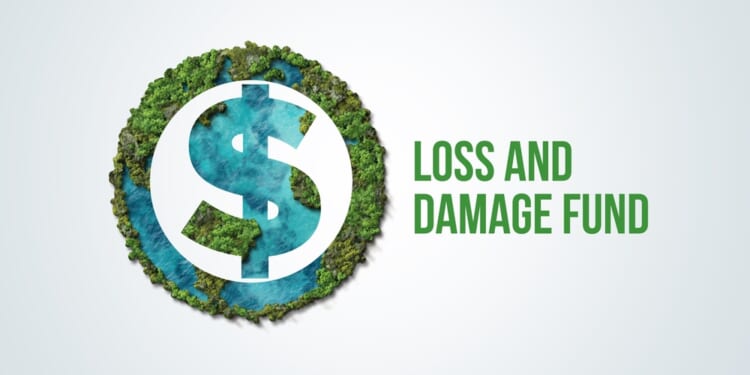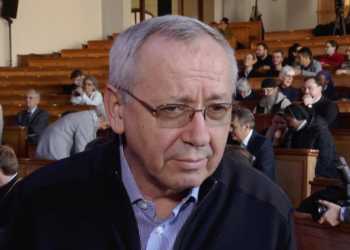Nuclear energy can serve as the “bridge” in the discussion between geopolitical and energy security on one side, and decarbonization and development on the other. Including nuclear energy in the Loss and Damage Fund can strengthen US nuclear leadership and help the Global South build low-carbon solutions that support water security and economic growth.
There is a clear correlation between electrification and prosperity. Intergovernmental organizations have recognized the economic and security imperative of developing reliable and resilient infrastructure, with the United Nations (UN) recognizing the need to close the “significant infrastructure gap in critical sectors” in developing countries, including energy and water infrastructure, to “greatly improve access to essential services, employment opportunities, economic growth and sustainable development.”
By 2050, the global urban population is expected to double, with nearly seven of 10 people living in urban areas, many being pulled by economic opportunities and pushed from agricultural disruptions, conflict, and other issues in rural areas. As urban populations continue to swell, energy, water, transportation, and other infrastructure must also grow to meet new residential, commercial, and industrial needs. Urban areas account for around 75 percent of current global energy consumption, which is projected to increase as urban populations continue to rise. However, more than 100 million people living in cities around the world lack access to electricity, with even greater numbers lacking access to safely managed drinking water.
With tremendous financial resources available to developing countries through the United Nations Fund for Responding to Loss and Damage (FRLD), many cities in the Global South have a unique opportunity to build the modern energy and water infrastructure needed to support the rising demands of growing urban centers. Given that much of this available funding is allocated based on climate vulnerabilities, recipient countries may be particularly concerned about the entrenchment of oil and gas infrastructure, and local governments will need to scrutinize a power source’s air quality impacts on urban environments and the feasibility of supporting dispersed ancillary infrastructure.
Fortunately, there is one technology that fits the bill—nuclear energy—with small modular reactors (SMRs) and microreactors (MMRs) of particular relevance to the Global South. While some countries in the Global South may still consider large reactors (given their economies of scale and more proven designs), SMRs and MMRs offer affordability and greater site flexibility and scalability. Nuclear-powered electricity provides several key benefits over fossil- and renewable-powered sources:
- Low-carbon baseload power with over a 90 percent capacity factor—nearly double that of coal and hydropower and triple that of wind and solar;
- Ability to be located close to demand centers, reducing the need for ancillary infrastructure requirements, such as long-range transmission lines (this is particularly attractive for co-location with desalination plants for certain coastal developing countries with water scarcity concerns);
- Absence of polluting air emissions and greenhouse gases during operation, resulting in enhanced air quality when compared to fossil-fuel powered sources—critical for public health concerns in urban environments;
- Lack of price and geopolitical volatility present in the oil and gas markets; and
- Creation of long-term infrastructure solutions with attractive total system costs.
While traditional mega-projects in the energy and infrastructure sectors have been subject to budget and schedule overruns, modern problems require modern solutions, and a first-of-a-kind fleet of SMRs or MMRs focused on standardized, modular construction and technology-driven project management can be deployed to meet this growing challenge.
The Available Funding Initiatives
There are numerous funds supporting infrastructure and other social development projects in the Global South. These include the Global Environment Facility, the Green Climate Fund, the Special Climate Change Fund, the Least Developed Countries Fund, the Adaptation Fund, and the Fund for Responding to Loss and Damage, among many others. Many of the UN-supported funds provide loans and grants focusing on environmental issues, like sustainable land use and biodiversity, as well as infrastructure projects focused on renewable-powered energy sources and energy and water efficiency improvements.
Certain funds founded in the early aughts, together with many commercial banks, have excluded nuclear energy from their project eligibility criteria, due to an allegiance to renewable energy growth, non-proliferation concerns, antiquated public perception of the industry, and historic political preferences, among others.
However, times are changing. Those decisions occurred during a prior geopolitical decade, made before the clear impacts were being felt from accelerating urbanization in developing countries, growing global migration, and the growth of data centers and artificial intelligence (AI), among other global and climactic forces. This recent shift in perspective has brought a renewed pragmatism and a recognition of the importance of nuclear energy in solving an increasingly complex puzzle of economic, political, and environmental issues. In 2023, at the twenty-eighth Conference of the Parties (COP), 22 countries signed a declaration to triple nuclear energy capacity by 2050. More recently, in June 2025, the World Bank reversed its decades-long ban on funding nuclear energy projects and is now partnering with the International Atomic Energy Agency (IAEA) to help developing countries finance nuclear projects, including advanced reactors and SMRs.
The Fund for Responding to Loss and Damage & Nuclear Opportunities
The FRLD, established in Egypt at COP27 in 2022, is a fund with an opportunity to adhere to this more modern, pragmatic spirit. The FRLD is intended to assist climate-vulnerable developing countries by mobilizing external finance to address a variety of challenges associated with the adverse effects of climate change, including population migration and the need for climate-resilient reconstruction and recovery. The FRLD is also focused on addressing “slow onset events,” like increasing temperatures and desertification. It is mandated to mobilize financial resources through a combination of government and private sector partnerships, with a focus on innovative financing mechanisms.
Developing countries that are looking to securely position their urban centers for the next century should scrutinize any infrastructure’s total system costs, including lifespan, intermittency, and ancillary infrastructure requirements (including transmission lines and grid stabilization tools, such as peaker plants, generators, or battery storage), and clarify their grid goals—whether that be freedom from exposure to fossil fuel price volatility, carbon-free power, public health, or some other objective. Moreover, as countries in the Global South look to industrialize, intermittent generation is not conducive to supporting an advanced, industrialized economy.
Nuclear energy is particularly persuasive for FRLD-eligible countries where climactic events have historically impacted the power grid, where wind and solar-heavy regions are not geographically well matched to demand centers, and where there is a local reluctance to rebuild with oil and gas-fueled sources due to climate or public health concerns. Nuclear energy also provides unique opportunities for co-location with other energy-intensive infrastructure, for example, supporting desalination plants to improve water distribution for human consumption, agriculture, and/or industry, which is critical in the thirsty Global South. In addition to facilitating basic energy and water supply, grid stability and longevity are key factors. A single nuclear plant can deliver reliable baseload power for 80-100 years, whereas a variable-generation solar farm would come to the end of its operational lifecycle three to four times during such a period. Such baseload electricity also creates both temporary construction and permanent jobs, provides significant tax revenue, promotes a secondary economy around the facility, and promotes grid stability and decarbonization efforts—all at levels unmatched by other generation sources.
While the FRLD funds may not be sufficient to cover the full project costs, offsetting even some costs would help secure a carbon-free baseload power source for decades to come. In the lifecycle of a project, all money is not equal—funding during the Development Phase is the hardest to find and is the most impactful to the long-term success of the project. FRLD support provided prior to a Final Investment Decision can fund feasibility studies, advisor engagement, and Front-End Engineering Design work, among other processes, and nuclear infrastructure development (as recommended by the IAEA), all of which are critical to the future commercial success of any major infrastructure project, and especially in any region-wide grid stabilization effort.
The FRLD’s Governing Instrument cites a “streamlined and rapid approval process with simplified criteria” and a desire for projects to be locally driven and contextually appropriate. This guidance provides an opportunity for both governments and US private commercial interests to develop joint partnerships for the submission of bids for modern SMR and MMR nuclear projects.
Why Should the United States Support Energy Infrastructure Resiliency in the Global South?
The United States has declined to continue participating in the FRLD initiative, allowing other countries to fill the gap and position themselves for technology export to support these infrastructure projects abroad. However, nuclear energy exports are of strategic interest, as the United States looks to counter Russia and China in key countries and regions. Moreover, in the US, nuclear energy is one of the few areas of strong bipartisan support. Nuclear energy can serve as the “bridge” in the discussion between geopolitical and energy security on one side, and decarbonization and development on the other.
Deployment of US-manufactured nuclear technology abroad would foster long-term relationships with the host countries, promoting US non-proliferation, geostrategic, and commercial interests. While China’s industrial policy has led to its dominance in the renewable energy supply chain, the United States continues to have the opportunity to maintain US-led expertise in the nuclear industry and to be the primary source of nuclear technology export for the Global South, which could boost high-tech domestic manufacturing, and create a highly specialized supply chain and labor force, while creating or deepening strategic partnerships abroad. Further, modern and reliable energy grids in developing countries will help stabilize local economies, reducing the need for US intervention abroad to secure critical regions and US assets and interests.
Final Thoughts & Recommendations
One of the unique aspects of nuclear energy is that the talking points can be reordered, depending on the audience. Under the Biden administration, nuclear energy became part of the clean energy and decarbonization dialogue, whereas under the second Trump administration, the focus is on geopolitical concerns, energy security, and energy dominance. Regardless of the rationale for promoting and prioritizing nuclear energy, it is important to recognize four things:
- The Global South needs electrification for development.
- The world’s need for rapid decarbonization should not come at the expense of the Global South and its right to further economic development and stability.
- Nuclear energy is a pragmatic solution to both the development and decarbonization efforts of the Global South.
- If the United States is not front and center in this conversation, countries of US strategic interest and the regions that they occupy will look to other partners to solve their needs, which will have geostrategic consequences.
Notwithstanding the enumerated benefits, operationalizing a nuclear power plant will require significant financial and political capital. However, while not yet deployed at commercial scale, modern SMRs and MMRs are intended to be increasingly nimble, and significantly cheaper and faster to deploy than traditional large-scale nuclear plants. Given the fundamental importance of resilient critical infrastructure on the economic, security, and environmental health of a country, governments in the Global South should consider pursuing SMR and MMR nuclear options as they plan their energy grids of the future.
Connecting with the FRLD and other fund-eligible nations to identify ideal jurisdictions for SMR and MMR nuclear plant deployment would facilitate the development of both a robust domestic nuclear manufacturing supply chain and labor force for the United States, as well as a stable, carbon-free baseload power to fuel the economic development of cities in the Global South, opening new regions for further partnerships and commercial investment.
The FRLD board is still developing its funding request criteria and application and approval procedures, but it has approved an initial $250 million start-up package. Formal disbursement of funds is anticipated to begin in early 2026, following the finalization of pending processes.
The upcoming COP30, scheduled to take place from November 10 to 21, 2025, presents an opportunity to reintroduce nuclear energy into the development and decarbonization dialogue. The impact of COP30 remains to be seen, and, arguably, expectations are somewhat reserved in the lead-up to the meetings in Belem. However, with all the “buzz” around nuclear energy, now is the time for the United States to lead and to shape discussions on nuclear energy development in the Global South, or risk the industry and our partners leaving the United States behind. In the words of Seneca, “It’s not because things are difficult that we do not dare, it is because we do not dare that things are difficult.” And if we do not dare, we will find ourselves in a far more difficult world.
About the Authors: Paul Murphy and Lindsay Hall
Lindsay Hall is a Senior Consultant at Murphy Energy & Infrastructure Consulting, LLC, where she helps clients navigate the interdisciplinary challenges of international development, geopolitics, and the energy transition. Lindsay has over a decade of experience with complex energy infrastructure, with a particular specialty in the climate policy and decarbonization space. Previously, she served in the General Counsel’s Office of the U.S. International Development Finance Corporation, focusing on clean energy and competitor state risks. Prior to her public service, Lindsay was a Counsel at a major international law firm where her practice focused on project finance and environmental matters.
Paul Murphy is the Founder and Managing Director of Murphy Energy & Infrastructure Consulting, LLC, where he advises on legal, policy, and financing strategies for nuclear power projects worldwide. Recognized as an expert by the IAEA, NEA, and the U.S. government, he has represented developers, investors, and contractors across the global nuclear industry and is an eight-time appointee to the U.S. Secretary of Commerce’s Civilian Nuclear Trade Advisory Committee.
Image: DOERS/shutterstock
















